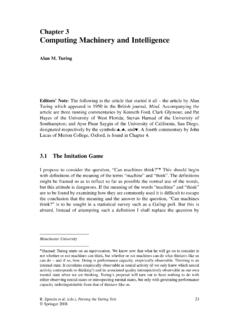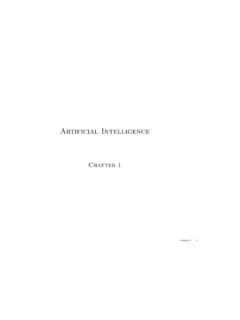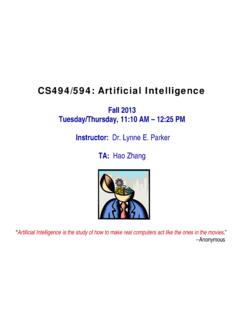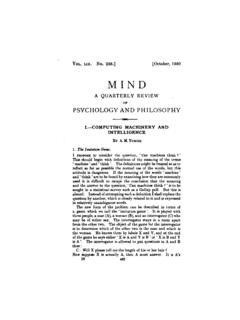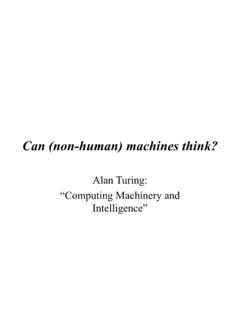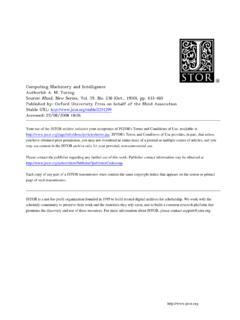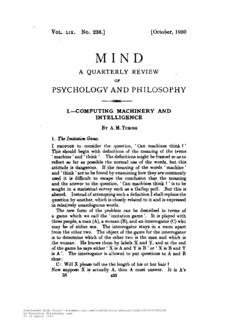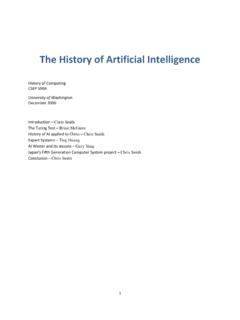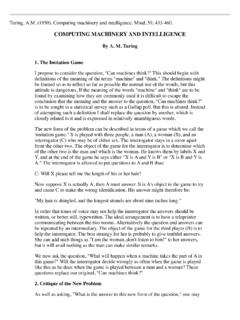Transcription of The Role of Artificial Intelligence in Software Engineering
1 2/27/2013 1 The Role of Artificial Intelligence in Software Engineering By: Mark Harman Presented by: Jacob Lear About the Author Mark Harman is a Professor of Software Engineering at University College London Director of CREST (Centre for Research on Evolution Search and Testing) Director for Research Council Funding Head of Software Systems Engineering Group Brief History of AI Artificial Intelligence (AI) can trace its roots back to the seminal work of Turing and McCarthy. Alan M. Turing (1912-1954) wrote " computing machinery and Intelligence in 1950 and proposed the Turing Test . John McCarthy (1927-2011) wrote Programs with Common Sense in 1959. Introduction Science Fiction or Commonplace? Computational Intelligence regularly provides examples of specific areas of intelligent behavior for which machines comfortably surpass the performance of even the best humans.
2 Since the 1950 s, AI has stimulated philosophical and technological debates, as well as interest and a little concern. 2/27/2013 2 AI and SE AI is about making machines intelligent. Software Engineering (SE) is the activity of defining, designing, and deploying complex and challenging systems. SE is one of the most challenging of all Engineering disciplines, but it is not recognized as such because Software is generally well concealed. AI and SE Not static fields of activity. More to come! During past 5 yrs. there have been important breakthroughs in AI. SE Difficulty Example Consider a tiny smartphone, which may contain 5 10 MLOC. The failure of just about any line could lead to total system failure. The space of inputs to even the smallest app on the phone is likely to exceed 1080, yet only one of these inputs may reveal such a critical fault.
3 Possible Solutions Software engineers have one critical advantage over other engineers: Software engineer s own material, Software , and tools can be used to attack challenges posed by production of systems. AI algorithms are well suited to such complex SE problems because they can replicate intelligent behavior. 2/27/2013 3 AI in SE SE community has used many algorithms, methods, and techniques that have emerged from the AI community in almost every area of SE activity. SE community has used 3 broad areas of AI techniques: Search Based Software Engineering (SBSE) Fuzzy and probabilistic methods for reasoning in the presence of uncertainty. Classification, learning, and prediction. When does AI for SE work well? 3 areas in which AI techniques are useful: Probabilistic Software Engineering Classification Learning and Prediction for Software Engineering Search Based Software Engineering (SBSE) Probabilistic Software Engineering Aim is to apply to SE, AI techniques developed to handle real world problems which are fuzzy and probabilistic.
4 Natural fit because, increasingly, SE needs to accommodate fuzzy, ill-defined, noisy, and incomplete information. Processes by which Software systems are built are often based on estimates. Examples of Probabilistic Software Engineering Bayesian probabilistic reasoning used to model Software reliability. Analysis of users requires probabilistic reasoning due to the stochastic nature of human behavior. 2/27/2013 4 Classification Learning and Prediction for Software Engineering Great interest in modeling and predicting Software costs during project planning. For example, a wide variety of machine learning techniques such as Artificial neural networks, case based reasoning, and rule induction have been used for Software project prediction, ontology learning, and defect prediction. Search Based Software Engineering Goal is to re-formulate SE problems as optimization problems that can be attacked with computational search.
5 Proven to be an applicable and successful approach, with applications from requirements and design to maintenance and testing. The virtual character of Software makes it an Engineering material ideally suited to computational search. Relationship Between Approaches to AI for SE AI techniques for SE reveal considerable overlaps. All ways in which AI has been applied to SE can be thought of as ways to optimize either the Engineering process or its products. The optimizations can usually be formulated as measurable objectives and constraints, the solutions to which reside in large spaces, making them ideal for computation search. Machine Learning Machine learning Essentially the study of approaches to computation that improve with use. To improve, need a way to measure improvement. With such a measure, can use SBSE to optimize according to it.
6 SE situations typically have many possible measurements against which improvement can be sought. 2/27/2013 5 Genetic Programming Genetic Programming Widely used computational search technique in SBSE and also a machine learning approach. Algorithm for learning models of Software behavior. Exciting recent breakthroughs in automatic bug fixing, porting between platforms, languages and programming paradigms, and trading functional and non-functional properties. Improvement is Learning Close connections between machine learning for SE and SBSE. One way of learning is to optimize! Progress that takes place during optimization = learning process! Steps to Application of AI in SE a suitable formulation of the SE problem so that AI techniques become applicable. opens a technological window of opportunity through which many AI techniques may pass. Example: SBSE can be used to optimize the performance of predictive models and case-based reasoners.
7 Challenges Ahead in AI for SE Searching for strategies rather than instances Current approaches of AI to SE tend to focus on solving specific problem instances. Scope to move up from there to whole classes of problems, and from there, to the provision of strategies for finding solutions. Some work has been done on ways of searching for derived probability distributions for statistical testing, inferring strategies from paths in model checking, and on the search for tactics for program transformations. Focuses on specific problems! 2/27/2013 6 Challenges Ahead in AI for SE Searching for strategies rather than instances How to migrate from searching for solution instances to searching for strategies for finding solutions? Search for strategies is a learning process over a training set. Exploit the natural connections between SBSE and machine learning!
8 Genetic Programming can generalize from solution of problem instances to solution of problem classes. It can characterize the strategies that find the next test input based in the behavior seen so far. Challenges Ahead in AI for SE Exploitation of Multicore Computation Many AI techniques used in SE are embarrassingly parallel they naturally decompose into sub-computations that can be carried out in parallel. Parallelization has been exploited in Software re-modularization, concept location, and regression testing. Principal challenge remains: finding ways to translate existing program paradigms into naturally parallelizable versions. Challenges Ahead in AI for SE Exploitation of Multicore Computation Without translation, execution on multicore systems is slower due to lower clock speeds than single-core CPU s. Many AI techniques for SE, and almost all for SBSE, are naturally parallelizable.
9 More cores = more scalability! Challenges Ahead in AI for SE Giving Insight to Software Engineers AI techniques offer ways to yield insight into the nature of SE problems and the spaces in which their solutions reside. Examples: SBSE used to reveal tradeoffs between requirements stakeholders and between requirements and their implementations and to bring aesthetic judgments into the Software design process. Many possible future ways in which AI techniques can be used to gain insight. 2/27/2013 7 Challenges Ahead in AI for SE Compiling Smart Optimization into Deployed Software Most work done so far on AI for SE has been applied off-line to improve the Software process or the Software itself. Why not compile the optimization process into the deployed Software so it becomes dynamically adaptive? To do so, need to identify parameters that should be optimized, which could be formulated as an optimization problem.
10 Work on genetic programming as a means of automatically patching, improving, and porting Software may be developed to provide in situ optimization. Could address long-standing challenges such as autonomic computing and self-adapting systems. Challenges Ahead in AI for SE Novel AI-Friendly Software Development and Deployment Need to adapt Software development processes to better accommodate the increasing use of automated smart AI-inspired tools. Example: Release a policy to account for the fact that faults can automatically be fixed. Automated patches may not initially be as trusted as human-generated patches. May need to be used in tandem with original system for ongoing regression testing. Challenges Ahead in AI for SE Novel AI-Friendly Software Development and Deployment If deployed Software takes advantage of dynamic optimization, in situ, then this has implications on the design of the Software with regards to how it obtains feedback from the user.
